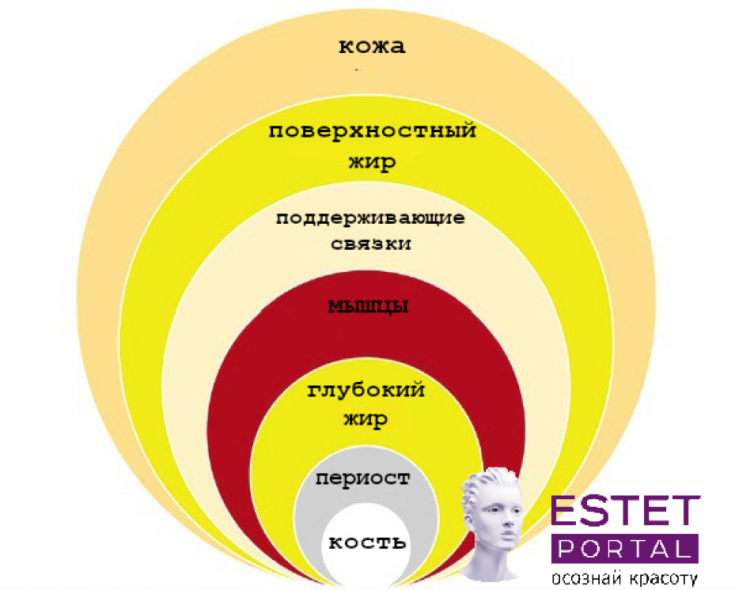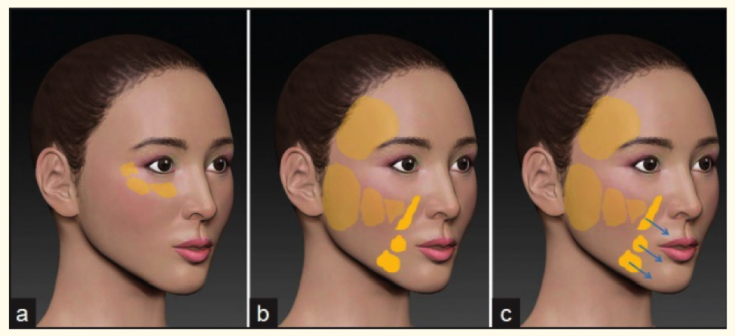From an anatomical point of view, deep and superficial fat compartments, skeleton and ligaments age in a rather predictable manner. Therefore, facial rejuvenation often consists in volume restoration with fillers. The "Two Planes" technique, based on anatomical logic, takes into account the peculiarities of the location of fat pads, and allows you to get the most natural and effective correction result.
More about contouring in the "Two planes" technique read on estet-portal.com in this article.
- Facial rejuvenation with fillers starts with understanding the anatomy of aging
- Two Plane Method: Anatomic Filler Injection Strategy
- Filler properties for work in Two planes technique
Facial rejuvenation with fillers starts with understanding the anatomy of aging
From the etiological point of view, loss of volume occurs mainly in the bone skeleton and fat compartments. For ease of understanding, the structure of the face can be represented as layers.

When aging, the bone layer undergoes resorption mainly in the orbital, periorbital, zygomatic, submalar areas and the lower jaw.
Fat compartments follow a rather predictable waste pattern:
- In the deep supraperiostal layer most of the volume loss occurs in the lateral and medial suborbicularis oculi fat pads, deep medial cheek and chin fat pads.
- In the superficial subcutaneous layer most of the volume loss occurs in the lateral regions, both in their temporal and preauricular regions, and to a lesser extent in the middle regions of the superficial buccal fat pad.

a) deep midface fat compartments (b) superficial midface fat compartments (c) displacement of central non-absorbable superficial fat pads
Smooth-Lifting: the perfect facial rejuvenation
All areas of fat reabsorption are located between the ligaments, so when there is a loss of adipose tissue volume, the ligaments are contoured on the face. All of these ligaments tend to retain their strength in the central region of the face where there is strong fixation, and loosen laterally.
Two Plane Method: Anatomic Filler Injection Strategy
As bone and fat aging progresses in a rather predictable fashion, the goal of restoring volumes in the face should follow a fairly standardized sequence targeting various areas of developing atrophy, to achieve voluminous rejuvenation of the entire face in a few sessions.
Read the most interesting articles in Telegram!
Injection areas are chosen exactly according to the anatomy, and the Two Planes strategy is based first on deep injections into the periosteal layer and then on superficial injections into superficial subcutaneous fat. The entire treatment typically requires three to monthly sessions.
Properties of fillers for working in the "Two Planes" technique
During the Double Plane correction, the most important factors to consider when selecting fillers are the viscoelasticity and cohesiveness of the material.
- Viscoelasticity describes the hardness or softness of a gel and is defined by its elasticity (how the filler is able to hold its shape when force is applied) and its viscosity (how how the filler resists gradual deformation under shear stress).
The higher the viscoelasticity, the higher the resistance to deformation and the ability to retain its shape, and therefore the better the lifting effect.
- Cohesivity describes the property of a gel to stick together when an external force is applied.
Higher cohesive gels tend to penetrate tissues more evenly.
Fillers with high elasticity are more suitable for working in deep planes as they maintain volume and create projection. For more delicate superficial areas we choose a filler with high cohesiveness, and after the procedure we definitely carry out a massage to distribute the filler as evenly as possible.
Layered facial rejuvenation: choosing the right sequence of procedures
Sometimes it is required to use filler with high elasticity and cohesiveness. This is especially important when working in areas where we need to simultaneously lift and restore volume, such as in the area of superficial cheek fat pads.
More useful and interesting information on our channel on YouTube:







Add a comment